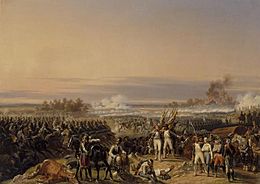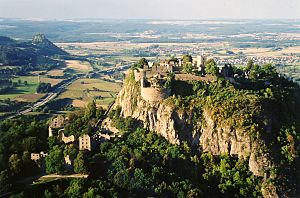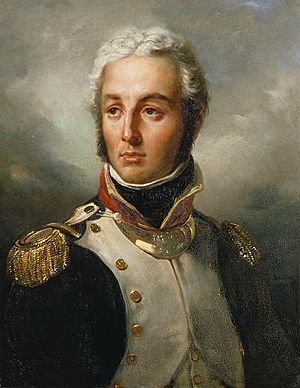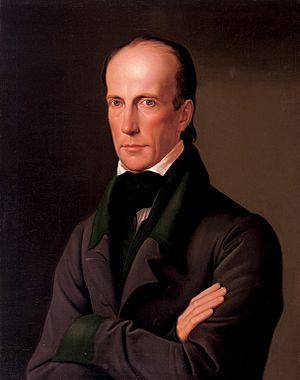Battle of Höchstädt (1800) facts for kids
Quick facts for kids Battle of Höchstädt |
|||||||
|---|---|---|---|---|---|---|---|
| Part of the War of the Second Coalition | |||||||
 Battle of Höchstädt by Hippolyte Lecomte, 1838 |
|||||||
|
|||||||
| Belligerents | |||||||
| Commanders and leaders | |||||||
| Jean Victor Marie Moreau | Pál Kray | ||||||
| Strength | |||||||
| 60,000 | 30,000 | ||||||
| Casualties and losses | |||||||
| approximately 2,000 | 5,000 dead, wounded and captured | ||||||
The Battle of Höchstädt was a major fight on June 19, 1800. It took place near the Danube River in what is now Germany. The battle was part of the War of the Second Coalition. The French army, led by General Jean Victor Marie Moreau, won a big victory. They defeated the Austrian army, led by Baron Pál Kray.
After this battle, the Austrians had to retreat to the strong fortress city of Ulm. Instead of attacking Ulm directly, which would have been very costly, Moreau cleverly attacked other Austrian forces. These forces were protecting the Danube River crossings further east. With their escape route cut off, the Austrians quickly left Ulm. They moved into Bavaria. This opened the way for the French army to advance towards Vienna, the capital of the Austrian Empire.
Controlling the Danube River was very important. It connected key cities like Ulm, Donauwörth, and Vienna. The army that controlled the Danube could control access to important areas like Munich. This battle's outcome was the opposite of what happened in 1704. In that year, the Second Battle of Höchstädt (also known as the Battle of Blenheim) helped protect Vienna from the French.
Contents
Why Did the Battle Happen?
The French Revolutionary Wars Continue
The Battle of Höchstädt was part of the French Revolutionary Wars. These wars involved France fighting against many European countries. The first big group of countries against France was called the First Coalition. They won some early battles. But then, Napoleon Bonaparte led French forces to victories in Italy. This forced Austria to sign peace agreements. These were the Peace of Leoben in 1797 and the Treaty of Campo Formio later that year.
However, these peace treaties were hard to follow. Austria was slow to give up some lands. There were also new uprisings in Switzerland and Naples. By 1799, the French government, called the French Directory, was tired of Austria's delays. They decided it was a good time to start new military campaigns. These campaigns would be in northern Italy and southwestern Germany.
Armies Prepare for Battle
At the start of 1800, the French and Austrian armies faced each other across the Rhine River. The Austrian commander was Feldzeugmeister Pál Kray. He had about 120,000 soldiers. This included Austrian troops and soldiers from other German states. About 25,000 of his men were protecting an area called the Vorarlberg. Kray kept his main army of 95,000 soldiers near the Rhine. He also stored most of his supplies at Stockach. This place was very close to French-held Switzerland. This was a risky move.
The French army was led by General of Division Jean Victor Marie Moreau. He had about 137,000 French troops. About 108,000 of these were ready for battle. Napoleon Bonaparte suggested a plan to attack the Austrians from Switzerland. But Moreau chose a different plan. He decided to cross the Rhine near Basel. This was where the river turned north.
Early Battles Lead to Höchstädt
Moreau used clever moves to trick Kray's army. He made it seem like he was attacking in one place, then moved his troops quickly. This allowed Moreau's forces to get behind parts of Kray's army. Battles happened at Engen and Stockach on May 3, 1800. The fighting at Engen was very tough for both sides. But the French captured Stockach. This was Kray's main supply base.
Losing Stockach forced Kray to retreat north to Meßkirch. This was a better place for defense. But it also meant Kray could not retreat into Austria through Switzerland. On May 4 and 5, the French attacked Meßkirch many times. They could not break through. However, at a nearby village called Krumbach, the French took control of high ground. This gave them a good view over Meßkirch.
Kray then had to pull his forces back to Sigmaringen. The French followed closely. More fighting happened at Biberach an der Ris on May 9. The Austrians again suffered heavy losses. They retreated to Ulm.
Who Fought at Höchstädt?
French Forces
The exact number of French troops at Höchstädt is not clear. It was likely around 40,000 to 60,000 soldiers. This was much more than the Austrian forces. The 94th Demi-brigade played a key role. They fought in Gremheim, a village near Höchstädt. This suggests that General Claude Jacques Lecourbe's army corps was present. Other generals like Laval and VanDamme were also likely there.
Moreau's own reports mentioned that the 6th chasseurs, 13th cavalry, 4th hussars, and 11th chasseurs fought well. He also said that General Grenier's forces were ready. General Dedon-Duclos also played an important part in the French victory.
Austrian Forces
The Austrian and Württemberg forces totaled about 20,000 men. They were led by FZM Count Anton Sztáray. The Württemberg troops were commanded by FML von Ferdinand August Freiherr von Hügel. This included infantry regiments and cavalry units. The Austrian regular army also had several cavalry regiments. These included the Royal Regiment Albert and the Hussar Regiment Vécsey.
Setting the Stage for Battle
Kray believed Moreau would follow him to the fortress at Ulm. So, he placed most of his Austrian and Württemberg troops there. Ulm was a very strong city. It had good access to both sides of the Danube River. Kray thought this would block Moreau's path into Bavaria.
Kray also placed smaller groups of soldiers at river crossings further east. These were meant to protect the bridges. If needed, they could destroy the stone bridges. Several bridges crossed the Danube between Ulm and Donauwörth. These included bridges at Leipheim, Günzburg, Dillingen, and Höchstädt. Each bridge was important for controlling the path into Bavaria.
Moreau's plan was to force Kray to either fight outside Ulm or leave the city. Ulm was blocking the main French army from entering Bavaria. To keep his army safe, Moreau needed to control at least half of the river crossings. His troops needed to march in a way that kept their backs away from the river. The more bridges they could capture, the safer their approach to Ulm would be.
The Main Battle
Moreau made it look like he was marching directly towards Ulm. Ulm was about twenty miles east of where the armies had fought earlier. But instead of attacking Ulm, Moreau's army suddenly turned east. They attacked the smaller Austrian forces guarding the river crossings.
General Lecourbe first captured positions in Landsberg and Augsburg. He left some troops behind to protect against Prince Reuss-Plauen. This prince was guarding the mountain routes to Vienna in Tyrol. Lecourbe then moved towards Dettingen, Blindheim (Blenheim), and Höchstädt.
General Grenier's troops were positioned with their right side near the Danube. General Richepanse protected both sides of the Iller River. He also kept the road from Ulm to Memmingen safe. Richepanse fought many small battles with the Austrians. Three reserve divisions were kept ready. They could support Lecourbe's attack on Ulm or Grenier's attack on Gunzburg.
Lecourbe pretended to attack the bridge at Dillingheim. But his scouts told him to focus on the bridges at Gremsheim, Blindheim, and Höchstädt. The next day, he did just that.
A Daring River Crossing
A small group of about 80 French soldiers from the 94th Demi-Brigade made an amazing river crossing. They took off their clothes and put their weapons on a small raft. Then, they swam across the river, pulling their weapons behind them. Once they reached the other side, they captured some Austrian cannons and supplies. They held their position until more French artillerymen could cross the damaged bridge at Gremsheim.
French engineers quickly rebuilt the bridges while under Austrian fire. This allowed the rest of the 94th Demi-Brigade to cross the river. This daring act was a turning point in the battle. Moreau himself wrote about it in his report.
A large Austrian force was still holding out at Höchstädt. But repeated attacks by French cavalry, including carabiners, cuirassiers, and hussars, forced them out. The French captured about 2,000 Austrian and Württemberg soldiers. They also took cannons and battle flags.
What Happened Next?
Once the French controlled the Danube crossings, Kray had no choice. He had to leave Ulm, leaving only a small group of soldiers behind. The French immediately surrounded the fortress at Ulm. On June 20, French soldiers captured a convoy of 300 wagons filled with grain. A few days later, a ceasefire stopped all fighting.
Emperor Francis II fired Pál Kray. He put his 18-year-old brother, Archduke John, in charge of the Austrian army. To help the young Archduke, the Emperor also appointed Franz von Lauer as deputy commander and Oberst (Colonel) Franz von Weyrother as Chief of Staff.
Moreau's campaign, which ended with Kray leaving Ulm, was one of his greatest successes. Napoleon Bonaparte had given Moreau specific orders, but Moreau chose to ignore them. Even so, their combined efforts greatly hurt the Austrian military.
In Spring 1800, while Moreau was winning in Germany, other French generals faced tough Austrian attacks in Italy. Napoleon brought in more troops and defeated the Austrians at the Battle of Marengo. The Battle of Höchstädt, which happened five days after Marengo, allowed the French to take Munich.
These big French victories forced the Austrians to agree to a ceasefire. This stopped the fighting for the rest of the summer. However, the French demanded a lot of money and supplies from the Bavarians. Even with these major losses, the Austrians did not want to agree to a bad peace deal. In mid-November, the French ended the truce. Moreau then won another big victory at Battle of Hohenlinden on December 3, 1800.
The peace treaty that followed, called the Peace of Lunéville, took away many of Austria's lands in Italy. It also made the Habsburgs recognize French control over areas like Switzerland. This treaty also set the stage for smaller German states to be absorbed by larger ones.
More to Explore
- Ulm Campaign 1805
- Battle of Blenheim also called Second Battle of Höchstädt
- First Battle of Höchstädt
Sources
Books and encyclopedia
- Arnold, James R. Marengo & Hohenlinden. Barnsley, South Yorkshire, UK: Pen & Sword, 2005. ISBN: 978-0967098500
- Barnes, Gregory Fremont. Napoleon Bonaparte. Osprey Publishing, 2012. ISBN: 978-0340569115
- Blanning, Timothy. The French Revolutionary Wars, New York, Oxford University Press, 1996. ISBN: 978-0340569115
- Clausewitz, Carl von (2021). The Coalition Crumbles, Napoleon Returns: The 1799 Campaign in Italy and Switzerland, Volume 2. Trans and ed. Nicholas Murray and Christopher Pringle. Lawrence, Kansas: University Press of Kansas. ISBN: 978-0700630349
- Eggenberger, David. "Höchstädt II", An Encyclopedia of Battles, Dover Publications, 2014. ISBN: 978-0486249131
- Herold, J. Christopher. The Age of Napoleon. Houghton Mifflin Company, 1963. ISBN: 978-0618154616
- History of the Wars of the French Revolution: Including Sketches of the Civil History of Great Britain and France, from the Revolutionary Movements, 1788, to the Restoration of a General Peace, 1815, Kuhl, France, 1820.
- Jomini, Antoine-Henri (Baron). The Art of War,Wilder Publications, 2008, p. 173. Originally published in English in 1862. ISBN: 978-1934255582
- Rothenberg, Gunther Erich. The Art of Warfare in the Age of Napoleon. Indiana University Press, 1980. ISBN: 978-0253202604
- Sloane, W.M. Life of Napoleon. France, 1896 (reprint, 1910), p. 109.
- Smith, Digby. The Napoleonic Wars Data Book. London: Greenhill, 1998. ISBN: 978-1853672767
- van Ess-Lodewyk, Willem. Extract of a letter from Gen. Moreau to the Minister of War, Neresheim, June 20. The London Chronicle. W. Day, 1810.




